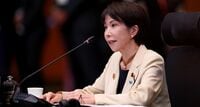By Linda Sieg
TOKYO (Reuters) - Japan on Monday unveiled a new name for the imperial era that begins on May 1, when Crown Prince Naruhito ascends the Chrysanthemum Throne.
"Reiwa" will be the name for the new era when Naruhito succeeds his father, Emperor Akihito, whose abdication on April 30 will end the 31-year Heisei era.
The imperial era name, or "gengo", is used on documents, newspapers, calendars and coins. It is the way many Japanese count years, although use of the Western calendar is becoming more widespread, and many use the two systems interchangeably.
ORIGINS OF GENGO
Japan imported the imperial calendar system from China about 1,300 years ago.
Starting with the Meiji era (1868-1912), it adopted the practice of "one emperor, one era name." Previously, era names were sometimes changed mid-reign, such as after disasters.
There have been four era names in the modern period: Meiji, Taisho (1912-1926), Showa (1926-1989) and the current Heisei.
There were calls to abolish the system after Japan's 1945 defeat in World War Two, but a law enacted in 1979 after a push by conservatives gave it new legal basis.
SELECTION PROCESS
Under modern guidelines the era name should be appropriate to the ideals of the nation, consist of two Chinese characters, be easy to write and read. It cannot be in common use or have been used in a previous combination.
The emperor does not choose the "gengo". The cabinet decides from a list of names suggested by scholars and bureaucrats.
Traditionally, characters were selected from ancient Chinese texts, but this time they were taken from a collection of Japanese classical poetry called Manyoshu.
The first character is most often understood to mean "order" or "command" but can also mean "good" and "beautiful". The second character means "peace" or "harmony".
The part of the Manyoshu that inspired the new name was translated by a scholar as: "It is now the choice month of early spring; the weather is fine, the wind is soft. The plum blossoms open - powder before a mirror; the orchids exhale - fragrance after a sachet."
The era name is sometimes abbreviated with its first letter in English, the gengo also customarily doesn't begin with the initials of the previous modern eras -- M, T, S or H.
FADING USE
Use of the imperial era name is slowly declining as Japan becomes more intertwined with the global economy.
A recent Mainichi newspaper poll showed 34 percent of people used mainly gengo in daily life; another 34 percent used both gengo and the Western calendar, while a quarter used mostly the Western system.
In 1975, 82 percent used mainly gengo, 13 percent used both and only 4 percent mainly the Western system.
City offices and government agencies mostly use the imperial era in their paperwork and computer systems, although companies generally use the Western calendar.
WELL-KEPT SECRET
The image of Chief Cabinet Secretary Keizo Obuchi announcing the Heisei era name on Jan. 8, 1989, by holding up a framed white placard with the characters hand-written in black ink is an enduring one for many Japanese.
This time, Chief Cabinet Secretary Yoshihide Suga did the honours, on live television.
To ensure the new name did not leak, officials involved had to hand in mobile phones and keep quiet until the announcement.
Instead of waiting for the new emperor to take over, the government decided to announce the name a month early. That will give software systems companies and printers time to prepare.
(Reporting by Malcolm Foster and Linda Sieg; editing by Darren Schuettler)



